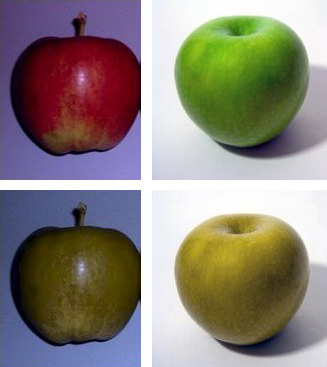Color blindness facts for kids
People with color blindness cannot tell the difference between certain colors. Sometimes, they might not see colors at all.
Most color blindness is inherited from parents. It usually follows simple Mendelian inheritance rules. But sometimes, it happens because of damage to the eyes, nerves, or the brain. It can also be caused by touching certain chemicals.
Most color blindness is permanent. However, some conditions can cause temporary color blindness. For example, during certain migraines, some people cannot tell colors apart. There is no cure for permanent color blindness.
Many more males are color blind than females. About five to eight percent of males are color blind. But less than one percent of females have this condition.
Color blindness is often seen as a disability. Yet, color blind people sometimes have an advantage. They can be better at seeing through some types of camouflage.
Contents
History of Color Blindness Discovery
In 1798, English chemist John Dalton published the first scientific article about color blindness. He did this after he found out he was color blind himself. The article was called "Extraordinary facts relating to the vision of colours." Because of his work, the condition is sometimes called daltonism. As of 2009, the word daltonism is used only for a specific type of color blindness called deuteranopia.
How We See Colors
There are three steps to telling the difference between colors:
- Light hits special nerve cells in the eye. These cells are called receptors. Some of them get stimulated and create an electrical signal.
- The signals travel along nerves to special parts of the brain.
- Those brain parts understand the signals. They turn the signals into an image. This image is then looked at closely to separate different objects. We see shapes and sometimes colors, linking them to other information.
How the Human Eye Sees Colors
Inside the human eye is a part called the retina. The retina takes in the images the eye sees. It sends these images to the brain. The retina has two types of cells: Rod cells and Cone cells. They work in different kinds of light.
- Rod cells see images when the light is dim. This happens at night or in a dark room.
- Cone cells see images in normal daylight or bright light. There are three types of cone cells. Each type has a different pigment. Each reacts to a different spectrum of light. One is sensitive to short wavelengths. Another is sensitive to medium wavelengths. The third is sensitive to long wavelengths. These wavelengths cover most of the visible light. Each color is "seen" based on how much each receptor is stimulated.
Parts of the thalamus and the visual cortex in the brain help us see, including seeing colors. So, color blindness can also happen if these brain areas, the optic nerve, or the retina are damaged. These types of color blindness usually happen because of an accident. They are not inherited. Inherited color blindness only affects the retina.
Sometimes, only a part of the visual field is affected by color blindness. The rest of the vision might be normal. Some types of color blindness, but not inherited ones, can be cured.
What Causes Color Blindness?
Several different problems can cause color blindness.
- If a person's eye has no cone cells, they cannot see any color at all. They can only see shades of dark and light.
- There are three types of cone cells in the human eye. If there are only two types, a person will have trouble telling certain colors apart. If there is only one type, a person will not see color at all.
- Sometimes cone cells change. This means they no longer react to the wavelengths they should. A person will need more of a certain color to see it. They see colors differently. They may not be able to tell certain colors apart. Most of these people do not know they are color blind. They have little trouble telling colors apart in most cases.
- Nothing may be wrong with the eye itself. But the nerves that carry information or the brain area that understands it may be damaged. This means the signal is interpreted incorrectly. The damage can be permanent or temporary. Certain brain conditions, like migraines, can change how people see colors.
Different Kinds of Color Blindness
Total Color Blindness
This condition is very rare. People with it can only see in black, gray, and white. They can only see differences in brightness and do not see color. This is called monochromacy.
There are two main types of total color blindness:
- Rod monochromacy (achromatopsia): The retina has no cone cells. This makes it hard to see even normal light levels. This means people with it are almost blind. It happens mostly on the island of Pingelap. This island is part of the Pohnpei state in the Federated States of Micronesia. There, it is called maskun. About one in 12 people on the island have it. A storm hit the island in the 18th century. Very few men survived. One of them carried a gene for rod monochromacy. Today, hundreds of people live there. About 30% have this gene.
- Cone monochromacy: The retina has both rods and cones. But it has only one type of cone. People with this can see patterns well in normal daylight. But they will not see hues (colors).
Red/Green Color Blindness
There are two kinds of red-green color blindness: protanopia or deuteranopia. Deuteranopia is the most common type of color blindness. Between five and ten percent of males have it. Those affected have trouble telling the difference between red and green. For people with protanopia, red looks darker. This often happens because they lack the receptors for long (protanopia) or medium (deuteranopia)-length light waves. Or, these receptors might have changed how sensitive they are.
Blue/Yellow Color Blindness
This type is called Blue-yellow color blindness (tritanopia). But people affected can usually tell the difference between blue and yellow. Instead, they cannot tell the difference between blue and green. They also struggle with yellow and violet. It is different from other types because it is not linked to sex. It affects both sexes equally. It happens because those affected lack receptors for short wavelengths. Or, these receptors might have changed their sensitivity.
Other Causes of Color Blindness
Sometimes, people have no problem seeing color. But their brain has trouble "telling" the color. It interprets it wrong. It is also possible that only certain parts of the eye have color blindness. People may become color blind because of other diseases. But after the disease goes away, they see normally again. This seems to happen with certain forms of migraine.
How Color Blindness is Passed Down
Males have one X and one Y chromosome. Females have two X chromosomes. Many of the genes for color vision are on the X chromosome. They are sex linked. This is why men are more often affected by color blindness than women.
The "color blind" gene helps non-color blind people see the difference between red and green. This gene is on the X chromosome. This means a male will be color blind if the single X chromosome he inherits from his mother has the color blind version of the gene. A female will inherit color blindness only if she inherits two X chromosomes with defective (mutant) color gene alleles. In other words, a female needs to get "color blind" genes from both parents to be color blind.
Testing for Color Blindness
Special tests have been developed. These usually show an image with dots of different sizes and colors. People will then see different images. Most often, these are Arabic numbers. Those with certain types of color blindness will see different numbers from people who are not color blind.
Many young children have not learned numbers yet. So, other tests have been made for them. These tests use symbols, like a square, a circle, or a car instead of numbers.
Design Changes for Color Blind People
A color code is when a lot of information is given by the color of an item. Such codes can be hard for color blind people to understand. Because of this, color should not be used alone to give information. Good graphic design avoids using only color coding or color differences to give information. This helps not only color blind people but also people with normal sight.
Cascading Style Sheets can be used on web pages. They let you create a different color scheme for color blind people. Certain color scheme generators help graphic designers see color schemes. They can see them as eight types of color blind people would see them.
Color blindness is very sensitive to changes in material. A red-green color blind person may not be able to tell colors apart on a map printed on paper. The same map on a computer screen or television may look normal. Also, some color blind people find it easier to tell colors apart on artificial materials. Examples are plastic or acrylic paints. It is harder on natural materials, like paper or wood. Thirdly, for some color blind people, color can only be distinguished if there is enough color. Thin lines might look black. But a thicker line of the same color can be seen in the correct color.

In some cases, it is important to understand information very quickly. The visual system may drop the colors and only work in shades of gray. This is important when designing the interfaces for things used in an emergency situation. Examples are emergency brakes or emergency telephones.
Because color blind people may not see the difference between colors like red and green, some countries have refused to give them driving licenses. For example, in Romania, people have started to change the laws. This is so color blind people can also drive legally.
In the United Kingdom, electricity wires in houses used to be red, black, and green. They were changed to brown, blue, and green/yellow. This was to help color blind people see the difference between the "live" and "earth" wires.
What Color Blindness Is Not
Many people do not understand color blindness. People who are color blind never swap the colors they cannot see. They may have trouble telling two colors apart. For example, they may have a problem finding the right kind of apple in the supermarket. The image below first shows how two apples look to a person with normal vision. Then it shows how they look to a person with red-green color blindness. The left apple is a Braeburn; it is red. The apple on the right is a Granny Smith; it is green. To someone with red-green blindness, the apples look almost the same color.
Images for kids
See also
 In Spanish: Daltonismo para niños
In Spanish: Daltonismo para niños













